Potential Flow Demonstrator
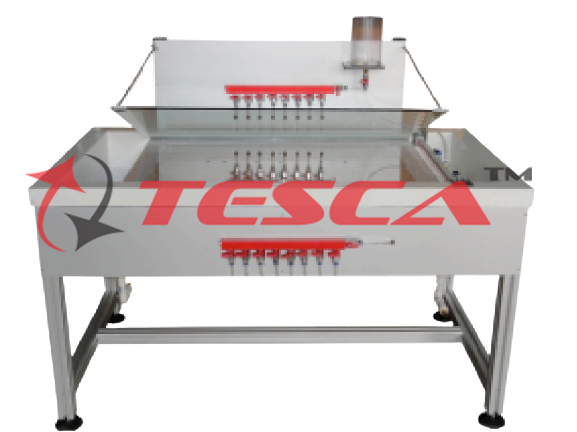
Order Code: 30104
Category: Fluid Mechanics Lab
Features: Two-dimensional, inviscid potential flow Visualization of streamlines Flow around different models: drag bodies and changes in cross-section Modeling the flow around bodies by overlaying the parallel flow and sources and/or sinks Sourc...
SPECIFICATION
Features:
Two-dimensional, inviscid potential flow
Visualization of streamlines
Flow around different models: drag bodies and changes in cross-section
Modeling the flow around bodies by overlaying the parallel flow and sources and/or sinks
Sources and sinks, individually or in combination
Tesca Potential Flow Demonstrator is a good approximation of the flow of ideal fluids: the potential flow. All physical systems described with the Laplace equation can be demonstrated with the potential flow. This includes current and thermal flows as well as magnetic flux. The core element of the trainer is a classic Hele-Shaw cell with additional water connections for sources and sinks. The laminar, two- dimensional flow is achieved by water flowing at low velocity in a narrow gap between two parallel glass plates. The parallel flow generated in this way is nonvertical and can be regarded as a potential flow. Sources and sinks are generated via eight water connections in the bottom glass plate. The streamlines are displayed on the glass plate by injecting a contrast medium (ink).
In experiments, the flow around bodies is demonstrated by inserting models into the parallel flow. Interchangeable models such as a cylinder, guide vane profile, or nozzle contour are included. To model the flow without models, it is possible to overlay parallel flow, sources, sinks, and dipoles as required. This allows the demonstration of the formation of Rankine half-bodies.
The water flow rate and the quantity of contrast medium injected can be adjusted by using valves. The water connections are also activated by valves and can be combined as required.
Specifications:
Demonstration of potential flow in a Hele-Shaw cell for visualizing streamlines
Flow around supplied models: cylinder, square, rectangle, guide vane profile, various models for changes in cross-section
Modeling the flow around contours without models by overlaying parallel flow with sources or sinks
Water as flowing medium and ink as a contrast medium
Hele-Shaw cell made of two glass plates arranged in parallel with narrow gap
Upper glass plate, hinged for swapping models
Bottom glass plate with cross-shaped water connections for generating sources/sinks can be combined as required
The grid in the bottom glass panel for optimal observation of the streamlines
Flow velocity, water inlet, and water outlet in sources/sinks as well as the dosage of the contrast medium can be adjusted by using valves
Technical Specifications:
2 glass plates, LxW: 910x585mm
Distance between the plates: 5mm
Bottom glass plate with eight water connections for sources/sinks Models
6 drag bodies
2 changes in cross-section
Material: rubber
Thickness: 5mm
Injection of the contrast medium (ink)
19 nozzles
Tank for contrast medium: 200mL
Experiments:
Visualization of streamlines in
Flow around drag bodies: cylinder, guide vane profile, square, rectangle
Flow-through models: nozzle contour, sudden contraction, or enlargement
Flow separation, flow with 90° deflection
Modeling the flow around bodies by overlaying parallel flow and sources and/or sinks
Formation of Rankine half-bodies
Demonstration of a dipole
The analogy between potential flow and other physical systems which are described by the Laplace equation
Requirements:
Water connection 300L/h, drain

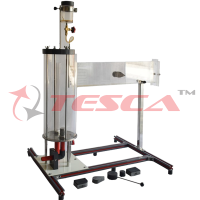
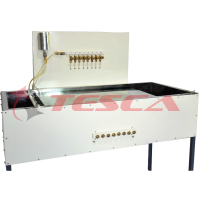
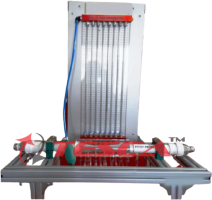

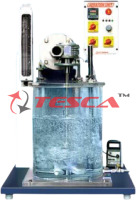
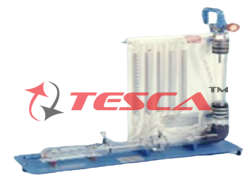
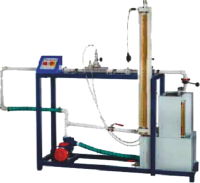
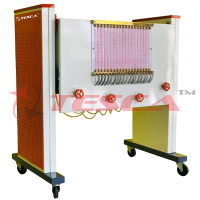
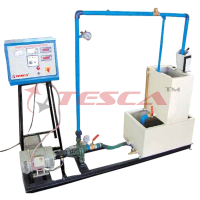

 91-9829132777
91-9829132777